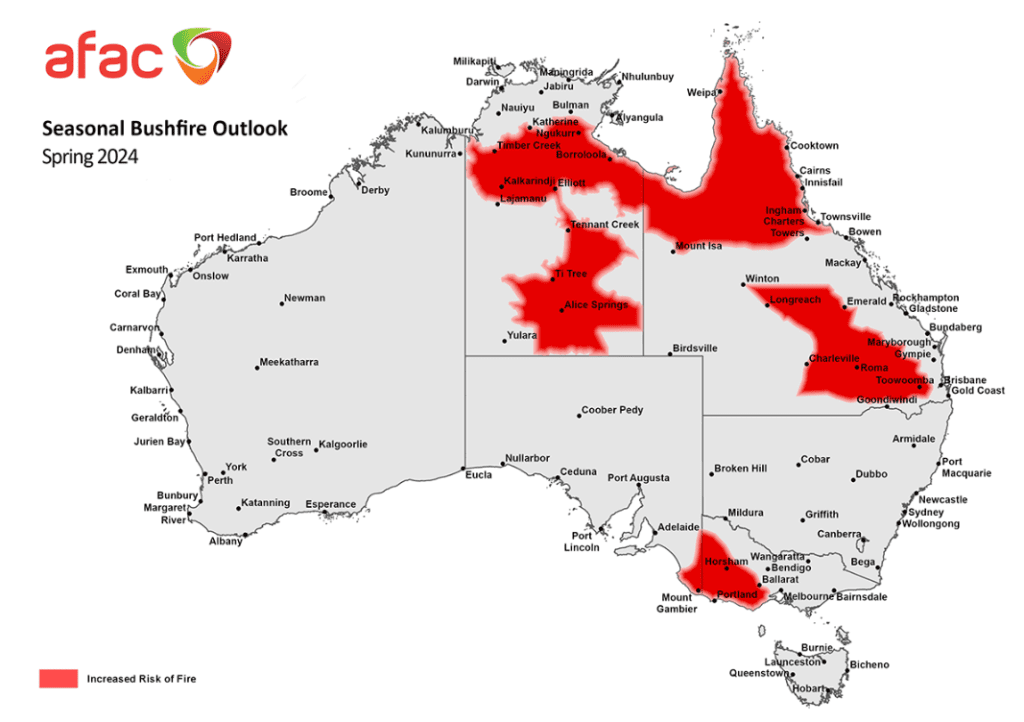
AN increased risk of fire for far west and south-west Victoria, south-east South Australia, large areas in the Northern Territory and Queensland, is indicated in AFAC’s latest Seasonal Bushfire Outlook for Spring 2024.
Fire authorities are advising communities of the potential for an early start to the fire season in parts of South Australia and Victoria, and extending to Tasmania if warm and dry conditions continue to dry out fuels towards summer.
 And AFAC, as the National Council for fire and emergency services, said with the change of seasons and risk of higher fire danger increasing across the country, now is the ideal time to prepare and refresh your understanding of the Australian Fire Danger Rating System (AFDRS).
And AFAC, as the National Council for fire and emergency services, said with the change of seasons and risk of higher fire danger increasing across the country, now is the ideal time to prepare and refresh your understanding of the Australian Fire Danger Rating System (AFDRS).
AFAC said mean temperatures for the year to date have been above average to very much above average for most areas, with areas of western WA and northern SA experiencing highest on record maximum temperatures for the period. In August, above average temperatures were widespread and it was the warmest August on record.
For spring, there continues to be an increased likelihood of unusually high maximum temperatures across most of Australia. There is an increased chance of above average rainfall for much of NSW, Queensland, eastern Tasmania and far southeast SA, while large parts of WA have an increased chance of below average rainfall.
For this outlook period, increased risk of fire for southern and central Queensland is driven by dry grasslands caused by winter frosts and dry winds. In northern Australia, unseasonal rainfall in Queensland and the Northern Territory has led to increased fuel loads. In both cases, fire authorities warn of increased fire danger as temperatures increase.
Further south, large parts of south-east Soth Australia, Western Australia and parts of Tasmania received rainfall in the lowest 10pc on record for the first half of the year. However, above average to well above average rainfall in August in south-west WA and western Tasmania eased dry conditions.
AFAC said while other parts of Australia show normal risk of fire during this outlook period, communities are encouraged to be vigilant and stay alert through winter months. Destructive and deadly fires can still occur during normal bushfire seasons across Australia.
AFAC chief executive officer Rob Webb urged communities to prepare and adhere to advice of local fire authorities this spring.
“Fire and emergency services are prepared for the fire season ahead and are here today to encourage communities to do the same.
“Now is the time to make a plan,” Mr Webb said.
“Understand your local risk, know where you will get your information, and talk to your family about what you will do.”
The seasonal outlook was developed by the Bureau of Meteorology, Queensland Fire Department, the NSW Rural Fire Service, ACT Emergency Services Agency, ACT Parks and Conservation Service, Country Fire Authority, Department of Energy, Environment and Climate Action Victoria, Tasmania Fire Service, SA Country Fire Service, Department of Fire and Emergency Services and Department of Biodiversity, Conservation and Attractions WA, Bushfires NT and AFAC.
Links to introductory eLearning for community, intermediate training for fire and land management professionals, and advanced training courses for FBANS and meteorologists, can all be found here https://www.afac.com.au/initiative/afdrs/afdrs-training
For additional technical information, resources are available on the AFAC webpage here https://www.afac.com.au/initiative/afdrs/technical-resources

HAVE YOUR SAY